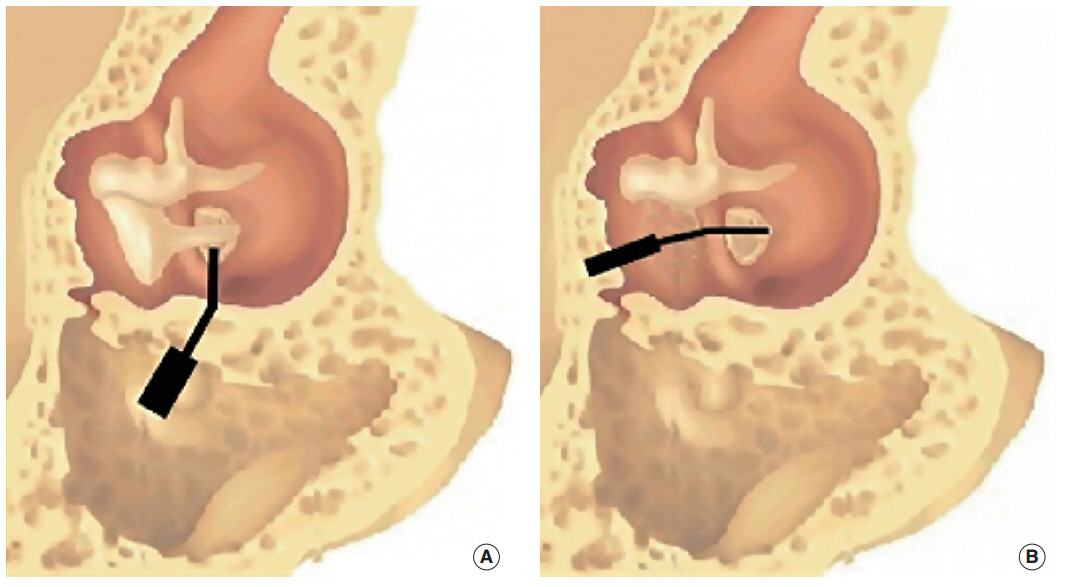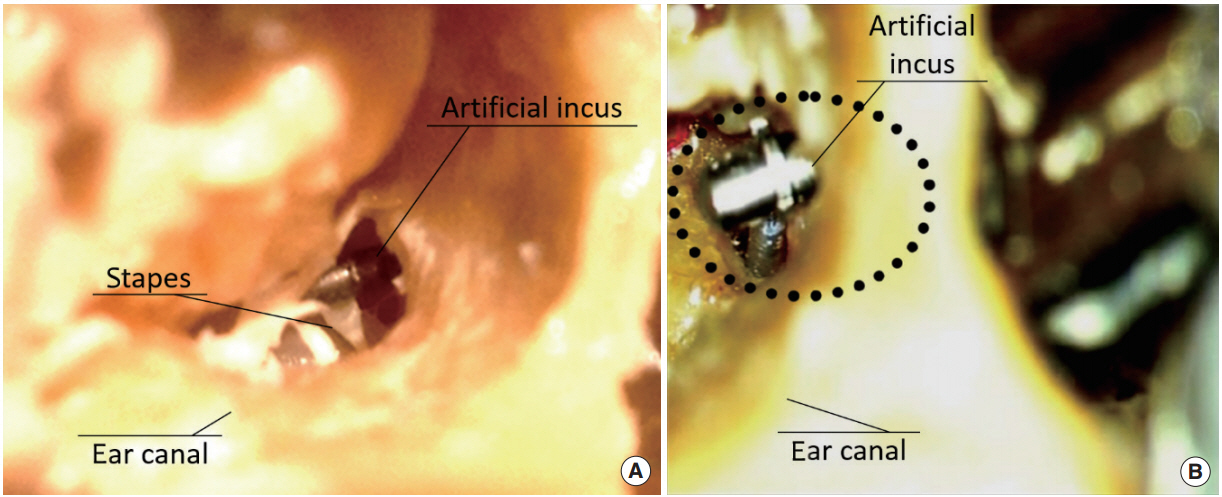Clin Exp Otorhinolaryngol.
2016 Dec;9(4):314-318. 10.21053/ceo.2015.01739.
A New Surgical Approach for Direct Acoustic Cochlear Implant: A Temporal Bone Study
- Affiliations
-
- 1ENT Audiology and Phoniatry Unit, University Hospital of Pisa, Pisa, Italy. l.bruschini@gmail.com
- KMID: 2360761
- DOI: http://doi.org/10.21053/ceo.2015.01739
Abstract
OBJECTIVES
The direct acoustic cochlear implant (DACI) is among the latest developments in the field of implantable acoustic prostheses. The surgical procedure requires a mastoidectomy and a posterior-inferior tympanotomy, with access to the facial recess at the level of the oval window, in a complex and lengthy surgical approach. Here, we report a new and considerably shorter surgical approach.
METHODS
The new approach involves positioning of artificial incus above the oval window through the superior-anterior tympanotomy. We performed DACI placement in temporal bone specimens (n=5) to assess the feasibility of the new approach.
RESULTS
The average time for the DACI implant in the temporal bones was only 112 minutes (range, 94 to 142 minutes) and there was little clinical risk associated with the procedure. Access was easy and drilling was minimal.
CONCLUSION
Our approach simplified the surgical procedure and consequently reduced the time required for DACI placement.
Keyword
Figure
Reference
-
1. Baumgartner WD, Boheim K, Hagen R, Muller J, Lenarz T, Reiss S, et al. The vibrant soundbridge for conductive and mixed hearing losses: European multicenter study results. Adv Otorhinolaryngol. 2010; 69:38–50.
Article2. Beltrame AM, Martini A, Prosser S, Giarbini N, Streitberger C. Coupling the Vibrant Soundbridge to cochlea round window: auditory results in patients with mixed hearing loss. Otol Neurotol. 2009; Feb. 30(2):194–201.3. Bernardeschi D, Hoffman C, Benchaa T, Labassi S, Beliaeff M, Sterkers O, et al. Functional results of Vibrant Soundbridge middle ear implants in conductive and mixed hearing losses. Audiol Neurootol. 2011; Sep. 16(6):381–7.
Article4. Bruschini P, Beltrame AM, Colletti V. Le protesi impiantabili dell’orecchio medio. In : In: Proceedings of Aggiornamenti Monografici 31° Convegno Nazionale di Aggiornamento; 2007 Oct; Cernobbio, Italy.5. Colletti V, Soli SD, Carner M, Colletti L. Treatment of mixed hearing losses via implantation of a vibratory transducer on the round window. Int J Audiol. 2006; Oct. 45(10):600–8.
Article6. Dumon T, Gratacap B, Firmin F, Vincent R, Pialoux R, Casse B, et al. Vibrant Soundbridge middle ear implant in mixed hearing loss. Indications, techniques, results. Rev Laryngol Otol Rhinol (Bord). 2009; 130(2):75–81.7. Martin C, Deveze A, Richard C, Lefebvre PP, Decat M, Ibanez LG, et al. European results with totally implantable carina placed on the round window: 2-year follow-up. Otol Neurotol. 2009; Dec. 30(8):1196–203.8. Hausler R, Stieger C, Bernhard H, Kompis M. A novel implantable hearing system with direct acoustic cochlear stimulation. Audiol Neurootol. 2008; Jun. 13(4):247–56.9. Lenarz T, Zwartenkot JW, Stieger C, Schwab B, Mylanus EA, Caversaccio M, et al. Multicenter study with a direct acoustic cochlear implant. Otol Neurotol. 2013; Sep. 34(7):1215–25.
Article10. Lenarz T, Verhaert N, Desloovere C, Desmet J, D’hondt C, Gonzalez JC, et al. A comparative study on speech in noise understanding with a direct acoustic cochlear implant in subjects with severe to profound mixed hearing loss. Audiol Neurootol. 2014; Jul. 19(3):164–74.
Article11. Bernhard H, Stieger C, Perriard Y. Design of a semi-implantable hearing device for direct acoustic cochlear stimulation. IEEE Trans Biomed Eng. 2011; Feb. 58(2):420–8.
Article12. Hausler R. Cochlear implantation without mastoidectomy: the pericanal electrode insertion technique. Acta Otolaryngol. 2002; Oct. 122(7):715–9.13. Zwartenkot JW, Snik AF, Kompis M, Stieger C. Gain and maximum output of implantable hearing devices in patients with moderate to severe sensorineural hearing loss. J Hear Sci. 2012; 2(2):35–40.
- Full Text Links
- Actions
-
Cited
- CITED
-
- Close
- Share
- Similar articles
-
- Cochlear Implantation after Bilateral Transverse Temporal Bone Fractures
- A Case of Cochlear Implantation after Bilateral Temporal Bone Fracture
- A Case of Electric Acoustic Stimulation Cochlear Implantation in Partial Deafness with Residual Low-Frequency Hearing
- Cochlear Implantation in a Deaf Patient with Bilateral Temporal Bone Fractures
- A Case of Cochlear Implantation Targeting Preserved Cerebral Cortex in Severe Traumatic Brain Injury



